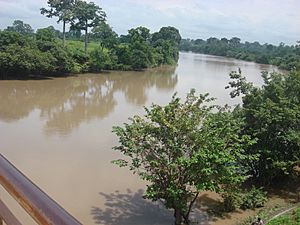Bandama River facts for kids
The Bandama River is the longest river in the country of Ivory Coast, which is located in West Africa. This important river stretches for about 800 kilometers (or 500 miles) from its start to where it flows into the ocean. It plays a big role in the geography and life of the region.
Contents
What is the Bandama River?
The Bandama River is a major waterway in the Ivory Coast. It begins in the northern part of the country and flows generally southwards. As it travels, it passes through different types of land, including forests and savannas. The river is a source of water for many communities and is important for local farming.
Where Does the Bandama River Start and End?
The Bandama River starts in the northern highlands of the Ivory Coast. These highlands are areas of higher ground where the river's journey begins. From there, it flows south until it reaches the Atlantic Ocean. Before it meets the ocean, the Bandama River forms a large lagoon system, which is a shallow body of water separated from the sea by a narrow strip of land. This lagoon system is called the Grand-Lahou Lagoon.
Why is the Bandama River Important?
The Bandama River is very important for the people and environment of the Ivory Coast.
- Water Source: It provides fresh water for drinking, farming, and other daily needs for many towns and villages along its path.
- Agriculture: Farmers use the river's water to irrigate their crops, especially rice, which is a staple food in the region.
- Transportation: In some parts, the river is used for local transportation, allowing people to move goods and travel between communities.
- Wildlife: The river and its surrounding areas are home to various animals, including fish, birds, and other wildlife.
Climate and Environment Around the River
The area around the Bandama River experiences different climates as the river flows from north to south.
- Northern Parts: The northern areas have a drier, tropical savanna climate with distinct wet and dry seasons.
- Southern Parts: Closer to the coast, the climate becomes more humid and tropical, with more rainfall throughout the year.
The river's flow can change a lot between the wet and dry seasons. During the rainy season, the water levels rise, and the river can sometimes flood. In the dry season, the water levels drop significantly.
Images for kids
See also
 In Spanish: Río Bandama para niños
In Spanish: Río Bandama para niños



